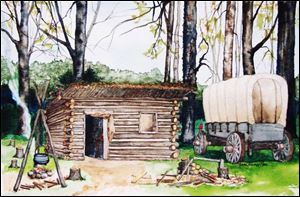
$830,000 state grant going to Archbold's Sauder Village
8/29/2007
An artist's rendering shows the type of wagon that carried settlers and provisions in the mid 19th century. A wagon will be made by a Nebraska craftsman for display in Sauder Village.
ARCHBOLD - An $830,000 state grant has been awarded to Sauder Village by the Ohio Cultural Facilities Commission for a project focusing on life in Ohio from 1834 to 1890.
The commission recently approved the grant for Sauder Village, a living-history destination where guests can experience life in northwest Ohio's Great Black Swamp through hands-on activities and stories shared by costumed guides in nearly 40 historic homes and shops.
The state grant will help pay for Sauder Village, located in Archbold, to continue its historic time line.
Plans call for the construction or relocation of 16 historic buildings including four historic homes, a summer kitchen, barn, school, wagon shop, jail, and church.
The initial phase of the time line was "Natives & Newcomers, 1803-1839."
Sauder received $30,000 from the Ohio Bicentennial Commission for that phase. The grant from the Ohio Cultural Facilities Commission marks the first time the village has received a significant amount of state funds, said Debbie David, Sauder Village's executive director.
The $830,000 grant is a vote of confidence from the state for the project, she said.
"We have really been recognized at the state level as an educational resource and as a major draw for tourism and economic development for the whole region," she said, adding the "state is really seeing this as an important asset and cultural facility."
When guests visit this new area, they will learn more about the decisions and struggles of the first European settlers as they traveled through the Great Black Swamp, said Kim Krieger, Sauder's director of marketing.
Guests will learn more about who the pioneers were, how they traveled to reach their new homes, and how they lived their daily lives. Demonstrations of historic farming, gardening, log hewing, and cooking are planned, and guests will be able to participate in hands-on activities.
A wagon that will be used in the village's new area is being constructed by a maker of historic wagons in Nebraska. The wagon is a reproduction of a mid 19th-century farm wagon that would have been pulled by oxen, Mrs. Krieger said.
The village already touches on that portion of the historic time line, but the new project will be much more complete and it will provide a chronological look at changes in homes, farms, schools, and other aspects of day-to-day life, Mrs. David explained. Work on the project will be done without disrupting the village's operations or its guests, Mrs. David said. Target opening date is spring, 2009.
Meantime, the village will raise funds for the local match. Total cost for the new project is $1.3 million.
The Ohio Cultural Facilities Commission oversees capital budget spending on facility improvement projects at non-profit theaters, museums, historical sites, and publicly owned professional sports venues.